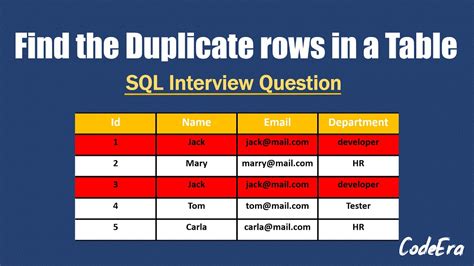Duplicate rows in a database can lead to inconsistencies and errors in data analysis and processing. Finding and managing these duplicates is crucial for maintaining data integrity. SQL provides various methods to identify duplicate rows, each with its own advantages and use cases. In this article, we will explore the different approaches to finding duplicate rows in SQL, including the use of the `GROUP BY` clause, `ROW_NUMBER()` function, and `RANK()` function, among others.
Key Points
- Understanding the concept of duplicate rows and their impact on data integrity
- Using the `GROUP BY` clause with `HAVING COUNT(*) > 1` to find duplicates
- Utilizing window functions like `ROW_NUMBER()` and `RANK()` for more complex scenarios
- Applying the `DISTINCT` keyword to eliminate duplicates from query results
- Considering the role of indexes in optimizing duplicate detection queries
Understanding Duplicate Rows

Duplicate rows refer to multiple rows in a database table that contain the same values for all columns or a subset of columns, depending on the context. These duplicates can arise from various sources, including data entry errors, inconsistencies in data import processes, or the lack of proper constraints during database design. The presence of duplicate rows can lead to incorrect data analysis, distorted statistics, and inefficient data processing.
Why Finding Duplicate Rows Matters
Identifying and managing duplicate rows is essential for maintaining the accuracy and reliability of database-driven applications. By detecting duplicates, database administrators and developers can take corrective actions, such as removing duplicates, merging duplicate records, or implementing preventive measures to avoid future duplicates. This process not only enhances data quality but also improves the overall performance and scalability of database systems.
Methods for Finding Duplicate Rows

SQL offers several methods for finding duplicate rows, catering to different scenarios and requirements. The choice of method depends on the database management system being used, the complexity of the query, and the specific needs of the application.
Using GROUP BY and HAVING COUNT()
The most straightforward method to find duplicate rows involves using the `GROUP BY` clause in combination with `HAVING COUNT(*) > 1`. This approach groups the rows by all columns (or a specified subset of columns) and then selects the groups that contain more than one row, indicating duplicates.
SELECT column1, column2,..., columnN
FROM tablename
GROUP BY column1, column2,..., columnN
HAVING COUNT(*) > 1;
Utilizing Window Functions
For more complex scenarios, window functions such as `ROW_NUMBER()`, `RANK()`, and `DENSE_RANK()` can be employed. These functions assign a unique number to each row within a partition of a result set, allowing for the identification of duplicate rows based on specific conditions.
SELECT *, ROW_NUMBER() OVER (PARTITION BY column1, column2 ORDER BY column1) AS row_num
FROM tablename
WHERE row_num > 1;
Using DISTINCT to Eliminate Duplicates
The `DISTINCT` keyword can be used to remove duplicate rows from query results. Although it does not directly identify duplicates, it helps in preventing duplicates from appearing in the output, thus maintaining data consistency.
SELECT DISTINCT column1, column2,..., columnN
FROM tablename;
Role of Indexes in Duplicate Detection
Indexes play a significant role in optimizing queries, including those used for duplicate detection. By creating indexes on the columns involved in duplicate checks, the performance of these queries can be substantially improved, especially in large databases.
| Method | Description |
|---|---|
| GROUP BY and HAVING COUNT() | Simple and effective for finding duplicates based on all or a subset of columns. |
| Window Functions | Powerful for complex scenarios, allowing for conditional duplicate detection. |
| INDEXES | Crucial for improving query performance, especially in large databases. |

Conclusion and Future Directions
Finding and managing duplicate rows is a critical aspect of database administration and application development. By understanding the different methods available in SQL, developers can choose the most appropriate approach for their specific use cases. As database systems continue to evolve, incorporating new features and functionalities, the importance of efficient duplicate detection and prevention strategies will only continue to grow.
What are duplicate rows in a database?
+Duplicate rows refer to multiple rows in a database table that contain the same values for all columns or a subset of columns.
Why is finding duplicate rows important?
+Finding duplicate rows is crucial for maintaining data integrity, preventing errors in data analysis, and ensuring the reliability of database-driven applications.
How can I find duplicate rows in SQL?
+You can find duplicate rows in SQL using the GROUP BY clause with HAVING COUNT() > 1, window functions like ROW_NUMBER(), or by utilizing the DISTINCT keyword to eliminate duplicates from query results.
